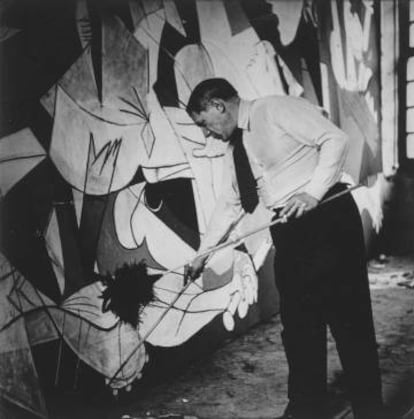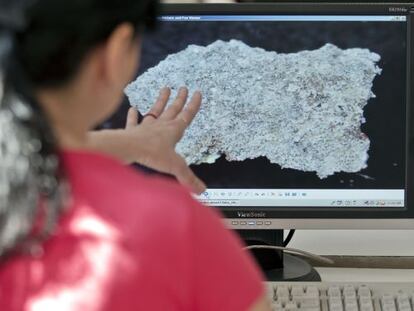Pursued by demons: Picasso and ‘Guernica’
New exhibition at Madrid’s Reina Sofia suggests famous painting born from personal crises
Pablo Picasso, arguably the 20th century’s most famous painter, created one of his most famous paintings, Guernica, at the request of the government of Spain’s Second Republic for the Paris International Exhibition of 1937, at the height of the Spanish Civil War.
Initially, Picasso, who was based in Paris at the time, wasn’t sure what to paint, but after the bombing in April 1937 of Guernica, a small, undefended and strategically unimportant town in the Basque Country by German and Italian planes, he began work on a 3.5 meter by 7.8 meter canvas, using only shades of black and grey, filled with agonized people and animals whose symbolic charge has stood the test of time, turning the painting into one of the most admired and loved works of art in the world.
It could be said the painting was born during a profound personal crisis for Picasso Reina Sofia director Manuel Borja-Villel
With the 80th anniversary of the painting coming up, and the 25th anniversary of its controversial move to the Reina Sofia in Madrid approaching, the contemporary art gallery is preparing a major exhibition for 2017. The project is titled Piety and terror in Picasso: The road to Guernica and is being curated by British art historian and writer T.J. Clark, who argues the painting’s germination took place long before Picasso learning of the bombing in the Basque Country.
For Clark, the origins of the work can be dated back to the 1920s after Picasso turned 40. By that time, he was already a successful and respected artist who had dazzled audiences with works such as The Young Ladies of Avignon, but he was also deeply affected by the destruction of World War I, while his private life was proving difficult to manage as he negotiated relationships with three different women: his wife Olga Khokhlova; his lover Marie-Thérèse Walter; and his latest muse Dora Maar.
The 2017 exhibition in Madrid – to be held from April 4 to September 4 – will be a major review centered on four main themes, with Guernica as the protagonist. The history of the painting will be told and the context in which it was created explained, as will the tale of the work’s odyssey and its eventual return to Spain. At the same time, the exhibition will highlight the latest theories about the painting.
At the center of the exhibition will be the room where the painting has been housed for the last quarter of a century, but an itinerant exhibit involving two trucks will focus on the Guernica’s travels.
Reina Sofia director Manuel Borja-Villel says the 2017 event will be most comprehensive exhibition ever dedicated to the famous painting.
The Reina Sofia exhibition has its origins in a series of conferences given by T. J. Clark in 2011, challenging widespread perceptions of Guernica. He later wrote Picasso and Truth. From Cubism to Guernica.

“It could be said the painting was born in the 1920s during a period of profound personal crises for Pablo Picasso caused by several factors,” explains Borja-Villel. “After his success with Cubism and having been shown everywhere, he had the feeling he had done everything already: he was no longer a bohemian artist, and on the horizon were artists like Dalí or Miró who, at least to begin with, were ahead of him conceptually.”
One of the other causes of the crisis was related to the horror of the World War I. “This is terror in the face of a new form of war. This is no longer about combat between soldiers on the field of battle,” says the Reina Sofia director. “For the first time you see the destruction caused by aircraft – that planes can carry out their objectives in a question of minutes, as happened in Guernica.”
The third reason for Picasso’s personal crisis related to his complicated love life. While he remained married to Olga Khokhlova – his first wife and the mother of his daughter Maya – he was also in a stable relationship with Marie-Thérèse Walter, his lover since 1927, and involved with the artist Dora Maar, his assistant since 1936 and the person he charged with documenting the creation of the Guernica painting.
The Reina Sofia exhibition will include 60 paintings by Picasso as well as a large number of drawings from museums around the world. Among the works on show will be The Three Dancers (1925) on loan from the Tate Gallery in London, and Woman Dressing her Hair (1940) lent by the MoMA. The exhibition will also highlight the high-precision restoration work carried out on Guernica since 2012, which has involved robots repairing damage caused to the giant canvas.
Guernica’s Odyssey
The Mexican-Spanish writer Max Aub asked Picasso to produce a work for the Spanish Republic to exhibit at the 1937 Paris International Exhibition. He could choose his theme and would be paid 150,000 French francs.
A symbol of the resistance of the Republican troops to the nationalist forces of future dictator Francisco Franco, the painting made its way around Europe and crossed the Atlantic several times as Spain's embattled Republicans tried to raise awareness of their cause. It was housed in Norway, Denmark, London, Los Angeles, San Francisco, São Paulo and Berlin until in the 1970s, Picasso asked for this constant movement to stop and for Guernica to be given a home in New York's Museum of Modern Art (MoMA) until Spain returned to democracy. In September 1981, almost six years after the death of Franco, and following a 42-year stay at the MoMA, Guernica was moved to Madrid.
English version by George Mills.
Tu suscripción se está usando en otro dispositivo
¿Quieres añadir otro usuario a tu suscripción?
Si continúas leyendo en este dispositivo, no se podrá leer en el otro.
FlechaTu suscripción se está usando en otro dispositivo y solo puedes acceder a EL PAÍS desde un dispositivo a la vez.
Si quieres compartir tu cuenta, cambia tu suscripción a la modalidad Premium, así podrás añadir otro usuario. Cada uno accederá con su propia cuenta de email, lo que os permitirá personalizar vuestra experiencia en EL PAÍS.
¿Tienes una suscripción de empresa? Accede aquí para contratar más cuentas.
En el caso de no saber quién está usando tu cuenta, te recomendamos cambiar tu contraseña aquí.
Si decides continuar compartiendo tu cuenta, este mensaje se mostrará en tu dispositivo y en el de la otra persona que está usando tu cuenta de forma indefinida, afectando a tu experiencia de lectura. Puedes consultar aquí los términos y condiciones de la suscripción digital.
More information
Últimas noticias
Most viewed
- Alain Aspect, Nobel laureate in physics: ‘Einstein was so smart that he would have had to recognize quantum entanglement’
- Alvin Hellerstein, a 92-year-old judge appointed by Bill Clinton, to preside over Maduro’s trial in New York
- Gilles Lipovetsky: ‘If you want to live better and fall in love, take Prozac, don’t look to philosophy’
- Cuba confirms death of 32 of its citizens in the US attack against Venezuela
- Why oil has been at the center of Venezuela-US conflicts for decades










































